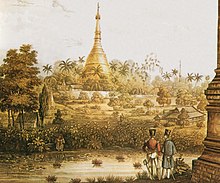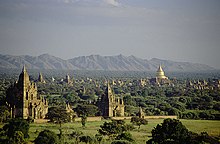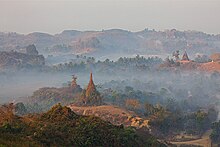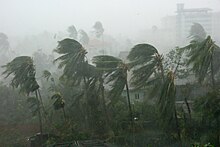Prehistory
Archaeological evidence shows that Homo erectus lived in the region now known as Burma as early as 750,000 years ago and Homo sapiens about 11,000 BC, in a Stone Age culture called the Anyathian, when plants and animals were first domesticated and polished stone tools appeared in Burma.[31] The Bronze Age arrived circa 1500 BC when people in the region were turning copper into bronze, growing rice and domesticating poultry and pigs; they were among the first people in the world to do so. The Iron Age arrived around 500 BC when iron-working settlements had emerged in an area south of present-day Mandalay.[32] Evidence also shows rice-growing settlements of large villages and small towns that traded with their surroundings as far as China between 500 BC and 200 AD.[33]Around the 2nd century BC the first-known city-states emerged in central Burma. The city-states were founded as part of the southward migration by the Tibeto-Burman-speaking Pyu, the earliest inhabitants of Burma of whom records are extant, from present-day Yunnan.[34][35] The Pyu culture was heavily influenced by trade with India, importing Buddhism as well as other cultural, architectural and political concepts, which would have an enduring influence on later Burmese culture and political organization.[36] By the 9th century AD several city-states had sprouted across the land: the Pyu states in the central dry zone, Mon states along the southern coastline and Arakanese states along the western littoral. The balance was upset when the Pyu states came under repeated attacks from the Kingdom of Nanzhao between the 750s and the 830s. In the mid-to-late 9th century the Mranma (Burmans/Bamar) of Nanzhao founded a small settlement at Pagan (Bagan). It was one of several competing city-states until the late 10th century when it grew in authority and grandeur.[37]
Imperial Burma
Pagan gradually grew to absorb its surrounding states until the 1050s–1060s when Anawrahta founded the Pagan Empire, the first ever unification of the Irrawaddy valley and its periphery. In the 12th and 13th centuries, the Pagan Empire and the Khmer Empire were two main powers in mainland Southeast Asia.[38] The Burmese language and culture gradually became dominant in the upper Irrawaddy valley, eclipsing the Pyu, Mon and Pali norms by the late 12th century. Theravada Buddhism slowly began to spread to the village level although Tantric, Mahayana, Brahmanic, and animist practices remained heavily entrenched. Pagan's rulers and wealthy built over 10,000 Buddhist temples in the Pagan capital zone alone. Repeated Mongol invasions (1277–1301) toppled the four-century-old kingdom in 1287.[39]Pagan's collapse was followed by 250 years of political fragmentation that lasted well into the 16th century. Like the Burmans four centuries earlier, Shan migrants who arrived with the Mongol invasions stayed behind. Several competing Shan states came to dominate the entire northwestern to eastern arc surrounding the Irrawaddy valley. The valley too was beset with petty states until the late 14th century when two sizable powers, Ava Kingdom and Hanthawaddy Kingdom, emerged. In the west, a politically fragmented Arakan was under competing influences of its stronger neighbors until the Kingdom of Mrauk U unified the Arakan coastline for the first time in 1437.
Early on, Ava fought wars of unification (1385–1424) but could never quite reassemble the lost empire. Having held off Ava, Hanthawaddy entered its golden age, and Arakan went on to become a power in its own right for the next 350 years. In contrast, constant warfare left Ava greatly weakened, and it slowly disintegrated from 1481 onward. In 1527, the Confederation of Shan States conquered Ava itself, and ruled Upper Burma until 1555.
Like the Pagan Empire, Ava, Hanthawaddy and the Shan states were all multi-ethnic polities. Despite the wars, cultural synchronization continued. This period is considered a golden age for Burmese culture. Burmese literature "grew more confident, popular, and stylistically diverse", and the second generation of Burmese law codes as well as the earliest pan-Burma chronicles emerged.[40] Hanthawaddy monarchs introduced religious reforms that later spread to the rest of the country.[41] Many splendid temples of Mrauk U were built during this period.
Political unification returned in the mid-16th century, due to the efforts of one tiny Toungoo (Taungoo), a former vassal state of Ava. Toungoo's young, ambitious king Tabinshwehti defeated the more powerful Hanthawaddy in 1541. His successor Bayinnaung went on to conquer a vast swath of mainland Southeast Asia including the Shan states, Lan Na, Manipur, the Chinese Shan states, Siam, Lan Xang and southern Arakan. However, the largest empire in the history of Southeast Asia unravelled soon after Bayinnaung's death in 1581, completely collapsing by 1599. Siam seized Tenasserim and Lan Na, and Portuguese mercenaries established Portuguese rule at Syriam (Thanlyin).
The dynasty regrouped and defeated the Portuguese in 1613 and Siam in 1614. It restored a smaller, more manageable kingdom, encompassing Lower Burma, Upper Burma, Shan states, Lan Na and upper Tenasserim. The Restored Toungoo kings created a legal and political framework whose basic features would continue well into the 19th century. The crown completely replaced the hereditary chieftainships with appointed governorships in the entire Irrawaddy valley, and greatly reduced the hereditary rights of Shan chiefs. Its trade and secular administrative reforms built a prosperous economy for more than 80 years. From the 1720s onward, the kingdom was beset with repeated Manipuri raids into Upper Burma, and a nagging rebellion in Lan Na. In 1740, the Mon of Lower Burma founded the Restored Hanthawaddy Kingdom. Hanthawaddy forces sacked Ava in 1752, ending the 266-year-old Toungoo Dynasty.

A British 1825 lithograph of Shwedagon Pagoda shows British occupation during the First Anglo-Burmese War.
The breadth of this empire was short lived. Burma lost Arakan, Manipur, Assam and Tenasserim to the British in the First Anglo-Burmese War (1824–1826). In 1852, the British easily seized Lower Burma in the Second Anglo-Burmese War. King Mindon tried to modernize the kingdom, and in 1875 narrowly avoided annexation by ceding the Karenni States. The British, alarmed by the consolidation of French Indo-China, annexed the remainder of the country in the Third Anglo-Burmese War in 1885.
Konbaung kings extended Restored Toungoo's administrative reforms, and achieved unprecedented levels of internal control and external expansion. For the first time in history, the Burmese language and culture came to predominate the entire Irrawaddy valley. The evolution and growth of Burmese literature and theater continued, aided by an extremely high adult male literacy rate for the era (half of all males and 5% of females).[44] Nonetheless, the extent and pace of reforms were uneven and ultimately proved insufficient to stem the advance of British colonialism.
British Burma
Main articles: British rule in Burma and Burma Campaign

The landing of British forces in Mandalay after the last of the Anglo-Burmese Wars, which resulted in the abdication of the last Burmese monarch, King Thibaw Min.
With the fall of Mandalay, all of Burma came under British rule, being annexed on 1 January 1886. Throughout the colonial era, many Indians arrived as soldiers, civil servants, construction workers and traders and, along with the Anglo-Burmese community, dominated commercial and civil life in Burma. Rangoon became the capital of British Burma and an important port between Calcutta and Singapore.
Burmese resentment was strong and was vented in violent riots that paralysed Yangon (Rangoon) on occasion all the way until the 1930s.[45] Some of the discontent was caused by a disrespect for Burmese culture and traditions such as the British refusal to remove shoes when they entered pagodas. Buddhist monks became the vanguards of the independence movement. U Wisara, an activist monk, died in prison after a 166-day hunger strike to protest a rule that forbade him from wearing his Buddhist robes while imprisoned.[46]
On 1 April 1937, Burma became a separately administered colony of Great Britain and Ba Maw the first Prime Minister and Premier of Burma. Ba Maw was an outspoken advocate for Burmese self-rule and he opposed the participation of Great Britain, and by extension Burma, in World War II. He resigned from the Legislative Assembly and was arrested for sedition. In 1940, before Japan formally entered the Second World War, Aung San formed the Burma Independence Army in Japan.
A major battleground, Burma was devastated during World War II. By March 1942, within months after they entered the war, Japanese troops had advanced on Rangoon and the British administration had collapsed. A Burmese Executive Administration headed by Ba Maw was established by the Japanese in August 1942. Wingate's British Chindits were formed into long-range penetration groups trained to operate deep behind Japanese lines.[47] A similar American unit, Merrill's Marauders, followed the Chindits into the Burmese jungle in 1943.[48] Beginning in late 1944, allied troops launched a series of offensives that led to the end of Japanese rule in July 1945. However, the battles were intense with much of Burma laid waste by the fighting. Overall, the Japanese lost some 150,000 men in Burma. Only 1,700 prisoners were taken.[49]
Although many Burmese fought initially for the Japanese, some Burmese, mostly from the ethnic minorities, also served in the British Burma Army.[50] The Burma National Army and the Arakan National Army fought with the Japanese from 1942 to 1944, but switched allegiance to the Allied side in 1945.
Following World War II, Aung San negotiated the Panglong Agreement with ethnic leaders that guaranteed the independence of Burma as a unified state. Aung Zan Wai, Pe Khin, Bo Hmu Aung, Sir Maung Gyi, Dr. Sein Mya Maung, Myoma U Than Kywe were among the negotiators of the historical Panglong Conference negotiated with Bamar leader General Aung San and other ethnic leaders in 1947. In 1947, Aung San became Deputy Chairman of the Executive Council of Burma, a transitional government. But in July 1947, political rivals[51] assassinated Aung San and several cabinet members.[52]
Independence

British governor Hubert Elvin Rance and Sao Shwe Thaik at the flag raising ceremony on 4 January 1948 (Independence Day of Burma).
The geographical area Burma encompasses today can be traced to the Panglong Agreement, which combined Burma Proper, which consisted of Lower Burma and Upper Burma, and the Frontier Areas, which had been administered separately by the British.[54]
In 1961, U Thant, then the Union of Burma's Permanent Representative to the United Nations and former Secretary to the Prime Minister, was elected Secretary-General of the United Nations, a position he held for ten years.[55] Among the Burmese to work at the UN when he was Secretary-General was a young Aung San Suu Kyi, who went on to become winner of the 1991 Nobel Peace Prize.
Military rule
On 2 March 1962, the military led by General Ne Win took control of Burma through a coup d'état and the government has been under direct or indirect control by the military since then. Between 1962 and 1974, Burma was ruled by a revolutionary council headed by the general, and almost all aspects of society (business, media, production) were nationalized or brought under government control under the Burmese Way to Socialism,[56] which combined Soviet-style nationalisation and central planning with the governmental implementation of superstitious beliefs.[citation needed] A new constitution of the Socialist Republic of the Union of Burma was adopted in 1974. Until 1988, the country was ruled as a one-party system, with the General and other military officers resigning and ruling through the Burma Socialist Programme Party (BSPP).[57] During this period, Burma became one of the world's most impoverished countries.[58]There were sporadic protests against military rule during the Ne Win years and these were almost always violently suppressed. On 7 July 1962, the government broke up demonstrations at Rangoon University, killing 15 students.[56] In 1974, the military violently suppressed anti-government protests at the funeral of U Thant. Student protests in 1975, 1976 and 1977 were quickly suppressed by overwhelming force.[57]
In 1988, unrest over economic mismanagement and political oppression by the government led to widespread pro-democracy demonstrations throughout the country known as the 8888 Uprising. Security forces killed thousands of demonstrators, and General Saw Maung staged a coup d'état and formed the State Law and Order Restoration Council (SLORC). In 1989, SLORC declared martial law after widespread protests. The military government finalised plans for People's Assembly elections on 31 May 1989.[59] SLORC changed the country's official English name from the "Socialist Republic of the Union of Burma" to the "Union of Myanmar" in 1989.
In May 1990, the government held free elections for the first time in almost 30 years and the National League for Democracy (NLD), the party of Aung San Suu Kyi, won 392 out of a total 489 seats (i.e., 80% of the seats). However, the military junta refused to cede power[60] and continued to rule the nation as SLORC until 1997, and then as the State Peace and Development Council (SPDC) until its dissolution in March 2011.
On 23 June 1997, Burma was admitted into the Association of Southeast Asian Nations (ASEAN). On 27 March 2006, the military junta, which had moved the national capital from Yangon to a site near Pyinmana in November 2005, officially named the new capital Naypyidaw, meaning "city of the kings".[61]

Protesters in Yangon during the 2007 Saffron Revolution with a banner that reads non-violence: national movement in Burmese. In the background is Shwedagon Pagoda.
In May 2008, Cyclone Nargis caused extensive damage in the densely populated, rice-farming delta of the Irrawaddy Division.[67] It was the worst natural disaster in Burmese history with reports of an estimated 200,000 people dead or missing, and damage totaled to 10 billion dollars (USD), and as many as 1 million left homeless.[68] In the critical days following this disaster, Burma's isolationist government hindered recovery efforts by delaying the entry of United Nations planes delivering medicine, food, and other supplies.[69]
In early August 2009, a conflict known as the Kokang incident broke out in Shan State in northern Burma. For several weeks, junta troops fought against ethnic minorities including the Han Chinese,[70] Wa, and Kachin.[71][72] During 8–12 August, the first days of the conflict, as many as 10,000 Burmese civilians fled to Yunnan province in neighbouring China.[71][72][73]
Reforms and transition towards democracy
The goal of the Burmese constitutional referendum of 2008, held on 10 May 2008, is the creation of a "discipline-flourishing democracy". As part of the referendum process, the name of the country was changed from the "Union of Myanmar" to the "Republic of the Union of Myanmar" and general elections were held under the new constitution in 2010. Observer accounts of the 2010 election day describe the event as mostly peaceful; however, allegations were raised in regard to polling station irregularities, and the United Nations (UN) and a number of Western countries condemned the elections as fraudulent.[74] One report documented 77 percent as the official turnout rate of the election.[75] The military-backed Union Solidarity and Development Party later declared victory, stating that it had been favoured by 80 percent of the votes; however, the claim was disputed by numerous pro-democracy opposition groups with an assertion that the military regime engaged in rampant fraud to achieve such a result.[75][76] The military junta was dissolved on 30 March 2011.Since the 2010 election, the government has embarked on a series of reforms to direct the country towards liberal democracy, a mixed economy and reconciliation, although the questioning of the motives that underpin such reforms has not ceased. The series of reforms includes the release of pro-democracy leader Aung San Suu Kyi from house arrest, establishment of the National Human Rights Commission, granting of general amnesties for more than 200 political prisoners, new labour laws that permit labour unions and strikes, relaxation of press censorship, and the regulation of currency practices.[77]
The impact of the post-election reforms has been observed in numerous areas, such as ASEAN's approval of Burma's bid for the position of ASEAN chair in 2014; the visit by United States Secretary of State Hillary Clinton in December 2011 for the encouragement of further progress—it was the first visit by a Secretary of State in more than fifty years[78] (Clinton met with Burmese president Thein Sein, as well as opposition leader Daw Aung San Suu Kyi);[79] and the participation of Aung San Suu Kyi's National League for Democracy (NLD) party in the 2012 by-elections, facilitated by the government's abolition of the laws that previously barred the NLD.[80] As of July 2013, about 100[81][82][83][84][85][86] political prisoners remain imprisoned, while conflict between the Burmese Army and local insurgent groups continues.
The by-elections occurred on 1 April 2012 and the NLD won 43 of the 45 available seats; previously an illegal organization, the NLD had never won a Burmese election up until this time. The 2012 by-elections was also the first time that international representatives were allowed to monitor the voting process in Burma.[87] Following the announcement of the by-elections, the Freedom House organization raised concerns about "reports of fraud and harassment in the lead up to elections, including the March 23 deportation of Somsri Hananuntasuk, executive director of the Asian Network for Free Elections (ANFREL), a regional network of civil society organizations promoting democratization."[88]
Civil war
Main articles: Internal conflict in Burma and Kachin Conflict
Civil wars have been a constant feature of Burma's socio-political
landscape since the attainment of independence in 1948. These wars are
predominantly struggles for ethnic and sub-national autonomy, with the
areas surrounding the ethnically Burman
central districts of the country serving as the primary geographical
setting of conflict. Foreign journalists and visitors require a special
travel permit to visit the areas in which Burma's civil wars continue.[89]In October 2012 the number of ongoing conflicts in Burma included the Kachin conflict,[90] between the Kachin Independence Army and the government;[91][92] a civil war between the Rohingya Muslims, and the government and non-government groups in Arakan State;[93] and a conflict between the Shan,[94][95] Lahu and Karen[96][97] minority groups, and the government in the eastern half of the country.
A widely publicised Burmese conflict was the 2012 Rakhine State riots, a series of conflicts that primarily involved the ethnic Rakhine Buddhist people and the Rohingya Muslim people in the northern Rakhine State—an estimated 90,000 people were displaced as a result of the riots.[98] The Burmese government previously identified the Rohingya as a group of illegal migrants; however, the ethnic group has lived in Burma for numerous centuries.[99]
In 2007 the German professor Bassam Tibi suggested that the Rohingya conflict may be driven by an Islamist political agenda to impose religious laws,[100] while non-religious causes have also been raised, such as a lingering resentment over the violence that occurred during the Japanese occupation of Burma in World War II—during this time period the British allied themselves with the Rohingya[101] and fought against the puppet government of Burma (composed mostly of Bamar Japanese) that helped to establish the Tatmadaw military organization that remains in power as of March 2013.
A UN envoy reported in March 2013 that unrest had re-emerged between Burma's Buddhist and Muslim communities, with violence spreading to towns that are located closer to Yangon.[102] The BBC News media outlet obtained video footage of a man with severe burns who received no assistance from passers-by or police officers even though he was lying on the ground in a public area. The footage was filmed by members of the Burmese police force in the town of Meiktila and was used as evidence that Buddhists continued to kill Muslims after the European Union sanctions were lifted on 23 April 2013.[103]








Tidak ada komentar:
Posting Komentar